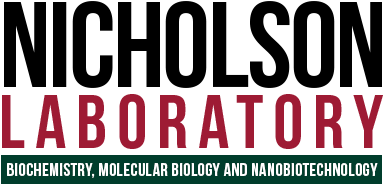Our Research
Ribonuclease function in post-transcriptional regulation
Gene expression in cells and viruses is regulated at multiple levels, including transcription and translation. Post-transcriptional gene regulation involves myriad RNA-protein and RNA-RNA interactions that determine the stability and functional capacity of coding and noncoding RNAs. Ribonucleases (RNases) are a diverse group of enzymes that cut RNA in site-specific manners, and are essential participants in post-transcriptional gene regulation. Ribonuclease action can control RNA maturation and degradation, and are under intensive study as potential disease therapeutic targets. Our research primarily focuses on RNase III – a highly conserved enzyme of bacterial cells that cleaves double-stranded(ds) structures in coding and noncoding RNAs. RNase III action regulates diverse cellular processes including virulence, antibiotic production and cell motility by controlling the expression of a defined network of genes termed the RNase III regulon. RNase III is subject to multiple levels of control, including covalent and noncovalent interactions that are currently only partially understood. We use biochemical, biophysical and genetic tools to understand the catalytic mechanism of RNase III and to characterize the cellular factors and processes that control the expression of the RNase III regulon.
Nucleic acid nanotechnologies for biosensing
DNA and RNA are not limited to their functions as the genetic material of cells and viruses: these biomolecules are now being used to construct complex nanostructures. Specifically, predesigned DNA and RNA molecules can undergo spontaneous self-assembly in vitro (or in vivo) to form nanodevices with diverse functions. The emerging field of structural DNA (and RNA) nanotechnology is providing new tools for the analysis of basic life processes, and applications in biomedicine. In collaboration with scientists at Temple University and at the University of Leeds, we are developing nucleic acid-based devices capable of highly sensitive, accurate detection of RNA and protein, with the ultimate goal of creating reliable, cost-effective devices for use in the clinic and point-of-care settings. We also are exploring the emergent physical properties of nucleic acid nanostructures. Understanding the novel behaviors of these structures will serve to inform and guide the design of functional devices with diverse applications, and also should provide insight on how macromolecular crowding influences reactions and processes in living systems.
LATEST NEWS:
Item 1
Item 2

